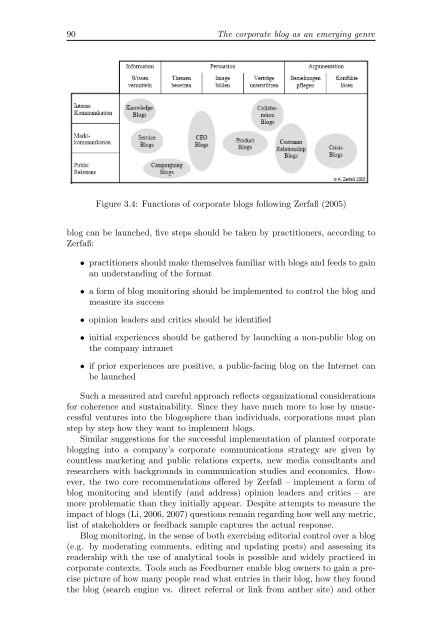The corporate blog as an emerging genre of computer ... - Oapen
The corporate blog as an emerging genre of computer ... - Oapen
The corporate blog as an emerging genre of computer ... - Oapen
You also want an ePaper? Increase the reach of your titles
YUMPU automatically turns print PDFs into web optimized ePapers that Google loves.
90 <strong>The</strong> <strong>corporate</strong> <strong>blog</strong> <strong>as</strong> <strong>an</strong> <strong>emerging</strong> <strong>genre</strong><br />
Figure 3.4: Functions <strong>of</strong> <strong>corporate</strong> <strong>blog</strong>s following Zerfaß (2005)<br />
<strong>blog</strong> c<strong>an</strong> be launched, five steps should be taken by practitioners, according to<br />
Zerfaß:<br />
• practitioners should make themselves familiar with <strong>blog</strong>s <strong>an</strong>d feeds to gain<br />
<strong>an</strong> underst<strong>an</strong>ding <strong>of</strong> the format<br />
• a form <strong>of</strong> <strong>blog</strong> monitoring should be implemented to control the <strong>blog</strong> <strong>an</strong>d<br />
me<strong>as</strong>ure its success<br />
• opinion leaders <strong>an</strong>d critics should be identified<br />
• initial experiences should be gathered by launching a non-public <strong>blog</strong> on<br />
the comp<strong>an</strong>y intr<strong>an</strong>et<br />
• if prior experiences are positive, a public-facing <strong>blog</strong> on the Internet c<strong>an</strong><br />
be launched<br />
Such a me<strong>as</strong>ured <strong>an</strong>d careful approach reflects org<strong>an</strong>izational considerations<br />
for coherence <strong>an</strong>d sustainability. Since they have much more to lose by unsuccessful<br />
ventures into the <strong>blog</strong>osphere th<strong>an</strong> individuals, corporations must pl<strong>an</strong><br />
step by step how they w<strong>an</strong>t to implement <strong>blog</strong>s.<br />
Similar suggestions for the successful implementation <strong>of</strong> pl<strong>an</strong>ned <strong>corporate</strong><br />
<strong>blog</strong>ging into a comp<strong>an</strong>y’s <strong>corporate</strong> communications strategy are given by<br />
countless marketing <strong>an</strong>d public relations experts, new media consult<strong>an</strong>ts <strong>an</strong>d<br />
researchers with backgrounds in communication studies <strong>an</strong>d economics. However,<br />
the two core recommendations <strong>of</strong>fered by Zerfaß – implement a form <strong>of</strong><br />
<strong>blog</strong> monitoring <strong>an</strong>d identify (<strong>an</strong>d address) opinion leaders <strong>an</strong>d critics – are<br />
more problematic th<strong>an</strong> they initially appear. Despite attempts to me<strong>as</strong>ure the<br />
impact <strong>of</strong> <strong>blog</strong>s (Li, 2006, 2007) questions remain regarding how well <strong>an</strong>y metric,<br />
list <strong>of</strong> stakeholders or feedback sample captures the actual response.<br />
Blog monitoring, in the sense <strong>of</strong> both exercising editorial control over a <strong>blog</strong><br />
(e.g. by moderating comments, editing <strong>an</strong>d updating posts) <strong>an</strong>d <strong>as</strong>sessing its<br />
readership with the use <strong>of</strong> <strong>an</strong>alytical tools is possible <strong>an</strong>d widely practiced in<br />
<strong>corporate</strong> contexts. Tools such <strong>as</strong> Feedburner enable <strong>blog</strong> owners to gain a precise<br />
picture <strong>of</strong> how m<strong>an</strong>y people read what entries in their <strong>blog</strong>, how they found<br />
the <strong>blog</strong> (search engine vs. direct referral or link from <strong>an</strong>ther site) <strong>an</strong>d other


